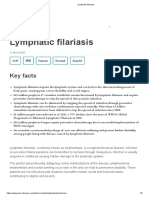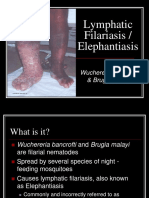Epidemiology: Wuchereria Bancrofti Brugia Malayi B. Timori
Epidemiology: Wuchereria Bancrofti Brugia Malayi B. Timori
Uploaded by
Ardya GarryCopyright:
Available Formats
Epidemiology: Wuchereria Bancrofti Brugia Malayi B. Timori
Epidemiology: Wuchereria Bancrofti Brugia Malayi B. Timori
Uploaded by
Ardya GarryOriginal Title
Copyright
Available Formats
Share this document
Did you find this document useful?
Is this content inappropriate?
Copyright:
Available Formats
Epidemiology: Wuchereria Bancrofti Brugia Malayi B. Timori
Epidemiology: Wuchereria Bancrofti Brugia Malayi B. Timori
Uploaded by
Ardya GarryCopyright:
Available Formats
Lymphatic filariasis is infection with the filarial worms, Wuchereria bancrofti, Brugia malayi or B. timori.
These parasites are transmitted to humans through the bite of an infected mosquito and develop into adult worms in the lymphatic vessels, causing severe damage and swelling (lymphoedema). Elephantiasis painful, disfiguring swelling of the legs and genital organs is a classic sign of late-stage disease. The infection can be treated with drugs. However, chronic conditions may not be curable by anti-filarial drugs and require other measures, eg. surgery for hydrocele, care of the skin and exercise to increase lymphatic drainage in lymphoedema. Annual treatment of all individuals at risk (individuals living in endemic areas) with recommended anti-filarial drugs combination of either diethyl-carbamazine citrate (DEC) and albendazole, or ivermectin and albendazole; or the regular use of DEC fortified salt can prevent occurrence of new infection and disease.
Epidemiology
The vector
Lymphatic filariasis is caused by infection with nematodes of the family Filarioidea: 90% of infections are caused by Wuchereria bancroftiand most of the remainder by Brugia malayi. Humans are the exclusive host of infection withW. bancrofti. Although certain strains of B. malayi can also infect some animal species (felines and monkeys), the life cycle in these animals generally remains epidemiologically distinct from that in humans. The major vectors of W. bancrofti are mosquitoes of the genus Culex (in urban and semiurban areas), Anopheles (in rural areas of Africa and elsewhere) and Aedes (in islands of the Pacific). The parasites of B. malayi are transmitted by various species of the genus Mansonia; in some areas, anopheline mosquitoes are responsible for transmitting infection. Brugian parasites are confined to areas of east and south Asia, notably India, Indonesia, Malaysia and the Philippines.
Forms and diagnosis Clinical manifestations Treatment and prevention
Geographical repartition
An estimated 120 million people in tropical and subtropical areas of the world are infected with lymphatic filariasis; of these, almost 25 million men have genital disease (most commonly hydrocele) and almost 15 million, mostly women, have lymphoedema or elephantiasis of the leg. Approximately 66% of those at risk of infection live in the WHO South-East Asia Region and 33% in the African Region.
Lymphatic filariasis
The disease
Lymphatic filariasis, commonly known as elephantiasis, is a painful and profoundly disfiguring disease. While the infection is usually acquired in childhood, its visible manifestations occur later in life, causing temporary or permanent disability. In endemic countries, lymphatic filariasis has a major social and economic impact. The disease is caused by three species of thread-like nematode worms, known as filariae Wuchereria bancrofti, Brugia malayi and Brugia timori. Male worms are about 34 centimetres in length, and female worms 810 centimetres. The male and female worms together form nests in the human lymphatic system, the network of nodes and vessels that maintain the delicate fluid balance between blood and body tissues. The lymphatic system is an essential component of the bodys immune system. Filarial infection can cause a variety of clinical manifestations, including lymphoedema of the limbs, genital disease (hydrocele, chylocele, and swelling of the scrotum and penis) and recurrent acute attacks, which are extremely painful and are accompanied by fever. The vast majority of infected people are asymptomatic, but virtually all of them have subclinical lymphatic damage and as many as 40% have kidney damage, with proteinuria and haematuria.
The transmission cycle
View a video of "the transmission cycle" [wmv format] Important: In order to view files in .wmv format, you will need Windows Media Player 9, Streaming mode. Multimedia help
Filariae are transmitted by mosquitoes. When a mosquito with infective stage larvae takes a blood meal, the parasites are deposited on the persons skin, from where they enter the body through the skin. These larvae then migrate to the lymphatic vessels and develop into adult worms over a period of 612 months, causing damage to and dilatation of the lymphatic vessels. The adult filariae live for several years in the human host. During this time, they produce millions of immature microfilariae that circulate in the peripheral blood and are ingested by mosquitoes that bite the infected human. The larval forms further develop inside the mosquito before becoming infectious to man. Thus, a cycle of transmission is established 1. Ottesen EA, Hooper PJ, Bradley M, Biswas G. The global programme to eliminate lymphatic filariasis: health impact after 8 years. PLoS Negl Trop Dis2008; 2: e317doi: 10.1371/journal.pntd.0000317 pmid: 18841205. 2. World Health Organization. Global programme to eliminate lymphatic filariasis.Wkly Epidemiol Rec 2006; 81: 221-32 pmid: 16749186. 3. World Health Organization. Elimination of yaws in India. Wkly Epidemiol Rec2008; 83: 125-32 pmid: 18404831.
Berdasarkan data Departemen Kesehatan, sampai Oktober 2009 penderita kronis filariasis tersebar di 386 kabupaten/kota di Indonesia. Sedangkan hasil pemetaan nasional diketahui prevalensi mikrofilaria sebesar 19%, artinya kurang lebih 40 juta orang di dalam tubuhnya mengandung mikrofilaria (cacing filaria) yang mudah ditularkan oleh berbagai jenis nyamuk. Bila tidak dilakukan pengobatan, mereka akan menjadi cacat menetap berupa pembesaran kaki, lengan, kantong buah zakar, payudara dan kelamin wanita. Selain itu, mereka menjadi sumber penularan bagi 125 juta penduduk yang tinggal di daerah sekitarnya.
You might also like
- Prep 2023Document909 pagesPrep 2023Imran A. Isaac100% (7)
- Exam Preparatory Manual, Paediatrics, Snehal Patel, 2eDocument2,737 pagesExam Preparatory Manual, Paediatrics, Snehal Patel, 2eklen83% (6)
- DDAL00-01 Window To The Past (5-10,11-16,17-20)Document65 pagesDDAL00-01 Window To The Past (5-10,11-16,17-20)Nando FerreiraNo ratings yet
- FILARIASIS PPT FINALDocument39 pagesFILARIASIS PPT FINALBinita Shakya100% (3)
- B IngDocument8 pagesB IngsanggrainiNo ratings yet
- BIOLOGY PROJECTS CLASS 12 CBSE INVESTIGTORY Elephantiasis Causes Cures Prevention, Treatment, Causes and Case Studies..Document28 pagesBIOLOGY PROJECTS CLASS 12 CBSE INVESTIGTORY Elephantiasis Causes Cures Prevention, Treatment, Causes and Case Studies..Gaurav Kumar63% (19)
- FilariasisDocument2 pagesFilariasismariaNo ratings yet
- Major Tropical Diseases - Prof. Dr. Sugeng JuwonoDocument48 pagesMajor Tropical Diseases - Prof. Dr. Sugeng JuwonosittihajarNo ratings yet
- Wuchereria BancroftiDocument6 pagesWuchereria BancroftiAinur RohmahNo ratings yet
- A. Readings DefinitionDocument5 pagesA. Readings DefinitionAisa ShaneNo ratings yet
- BP802T Lymphatic FilariasisDocument51 pagesBP802T Lymphatic FilariasisMisha ModiNo ratings yet
- Malaria: Malariae. Recently, It Has Been Recognized That P. Knowlesi, A Type of Malaria That NaturallyDocument32 pagesMalaria: Malariae. Recently, It Has Been Recognized That P. Knowlesi, A Type of Malaria That NaturallyFernanda DalyNo ratings yet
- Epidemiology and Control of Filariasis: Reshma Ann MathewDocument59 pagesEpidemiology and Control of Filariasis: Reshma Ann MathewHanna HonorisNo ratings yet
- Filariasis in NepalDocument41 pagesFilariasis in NepalBinaya100% (1)
- Nematodes of Filariidae FamilyDocument19 pagesNematodes of Filariidae FamilySonu NagargojeNo ratings yet
- Vector Borne DiseasesDocument7 pagesVector Borne DiseasesAbuzar KhanNo ratings yet
- Guidelines Filariasis Elimination IndiaDocument108 pagesGuidelines Filariasis Elimination IndiaegalivanNo ratings yet
- Lymphatic FilariasisDocument5 pagesLymphatic FilariasisawilakNo ratings yet
- What Is Lymphatic Filariasis?Document4 pagesWhat Is Lymphatic Filariasis?Camela Joy Domingo CentenoNo ratings yet
- FLARIASISDocument5 pagesFLARIASISHpu JogindernagerNo ratings yet
- Major Tropical Diseases-EditDocument50 pagesMajor Tropical Diseases-EditFitri TrianiNo ratings yet
- EPIDIMIOLOGYDocument4 pagesEPIDIMIOLOGYMaxamed Ali AadenNo ratings yet
- Filariasis 140310130022 Phpapp02Document18 pagesFilariasis 140310130022 Phpapp02알파No ratings yet
- Filariasis: Dr.T.V.Rao MDDocument62 pagesFilariasis: Dr.T.V.Rao MDDipankar NathNo ratings yet
- Filariasis and Its Importance in Humans: Aqsa 0684Document15 pagesFilariasis and Its Importance in Humans: Aqsa 0684kumailNo ratings yet
- Filariasis A. Readings: CD ReportDocument6 pagesFilariasis A. Readings: CD ReportAisa ShaneNo ratings yet
- Project Report On Human Diseases: PathogenDocument8 pagesProject Report On Human Diseases: PathogenPandit Shikhar TripathiNo ratings yet
- Filariasis: Fever Skin Lesions ElephantiasisDocument3 pagesFilariasis: Fever Skin Lesions ElephantiasisFoysal SirazeeNo ratings yet
- The Filariae: Lymphatic System, Subcutaneous and Deep Connective TissueDocument17 pagesThe Filariae: Lymphatic System, Subcutaneous and Deep Connective TissueKaranja GitauNo ratings yet
- Fasciola HepaticaDocument21 pagesFasciola HepaticaWande AyodeleNo ratings yet
- Lymphatic Filariasis PDFDocument12 pagesLymphatic Filariasis PDFBai Marifah LucasNo ratings yet
- Wuchereria BancroftiDocument4 pagesWuchereria BancroftiKevin ChebiiNo ratings yet
- Filariasis - Causes, Types, Symptoms, and ManagementDocument6 pagesFilariasis - Causes, Types, Symptoms, and ManagementChumaNo ratings yet
- What's Monkeypox ?Document10 pagesWhat's Monkeypox ?Fumika VenayaNo ratings yet
- Lymphatic FilariasisDocument5 pagesLymphatic FilariasisBALAJI POTBHARENo ratings yet
- Chapter 10Document16 pagesChapter 10ingridvirginia2006No ratings yet
- Filariasis: Signs and SymptomsDocument30 pagesFilariasis: Signs and SymptomsAnonymous VJjzqbAlNo ratings yet
- Don Dorathy SEMINAR REVIEWDocument53 pagesDon Dorathy SEMINAR REVIEWUdofia JuniorNo ratings yet
- Ayush Bajpayee (MALARIA)Document5 pagesAyush Bajpayee (MALARIA)Ayush BajpayeeNo ratings yet
- FILARIADocument25 pagesFILARIAKristina DavidNo ratings yet
- Harrison's Internal Medicine Chapter 211. Filarial and Related InfectionsDocument9 pagesHarrison's Internal Medicine Chapter 211. Filarial and Related InfectionsGaniNo ratings yet
- Parasitology Notes 4Document4 pagesParasitology Notes 4hassankhadijah000No ratings yet
- Mosquito Borne Diseases PHDocument23 pagesMosquito Borne Diseases PHjasmineNo ratings yet
- Lymphatic Filariasis / Elephantiasis: Wuchereria Bancrofti & Brugia MalayiDocument21 pagesLymphatic Filariasis / Elephantiasis: Wuchereria Bancrofti & Brugia MalayiLuvy ImmaduddinNo ratings yet
- Bacterial Disease 1. Pulmonary TuberculosisDocument7 pagesBacterial Disease 1. Pulmonary TuberculosiskanishqcNo ratings yet
- Filariasis: Parasitic Disease Roundworms Filarioidea Black Ies Mosquitoes HelminthiasesDocument9 pagesFilariasis: Parasitic Disease Roundworms Filarioidea Black Ies Mosquitoes Helminthiasesadandiba06No ratings yet
- 1) FilariasisDocument25 pages1) FilariasisNorbatNo ratings yet
- SchistosomiasisDocument4 pagesSchistosomiasisIram InayatNo ratings yet
- HELMINTOLOGIDocument20 pagesHELMINTOLOGIAnggis KusumaningtyasNo ratings yet
- Proquest Jurnal 7Document19 pagesProquest Jurnal 7Winda PNo ratings yet
- Synonyms of FilariasisDocument6 pagesSynonyms of FilariasisImam HakamNo ratings yet
- FilariasisDocument13 pagesFilariasiscristal pagcaliwanganNo ratings yet
- Vector Borne Diseases: Prof. Dr. Syed Sanowar AliDocument44 pagesVector Borne Diseases: Prof. Dr. Syed Sanowar AliAliNo ratings yet
- FilariasisDocument2 pagesFilariasisRidhen AniesNo ratings yet
- MalariaDocument18 pagesMalariaShail Tete55% (11)
- Lymphatic Filariasis / Elephantiasis: Wuchereria Bancrofti & Brugia MalayiDocument21 pagesLymphatic Filariasis / Elephantiasis: Wuchereria Bancrofti & Brugia Malayibernard allan mabantoNo ratings yet
- ElephantiasisDocument21 pagesElephantiasisPutri Anena AyuNo ratings yet
- Parasitology Notes 3-1Document14 pagesParasitology Notes 3-1hassankhadijah000No ratings yet
- Filariasis PCMDocument25 pagesFilariasis PCMfeva55No ratings yet
- Blood and Tissue NematodesDocument29 pagesBlood and Tissue Nematodesdeneke100% (2)
- Bioterrorism Agents/Diseases: Student Name: Ayesha AndleebDocument15 pagesBioterrorism Agents/Diseases: Student Name: Ayesha AndleebAisha rana100% (1)
- Filariasis: Causes, Tests, and Treatment OptionsFrom EverandFilariasis: Causes, Tests, and Treatment OptionsRating: 5 out of 5 stars5/5 (2)
- IhumanDocument10 pagesIhumanelias njagiNo ratings yet
- DVT Prevention EducationDocument5 pagesDVT Prevention Educationapi-549337910No ratings yet
- Algoritmo Diagnostico en SdraDocument8 pagesAlgoritmo Diagnostico en SdraPierina VeramatosNo ratings yet
- Diseases of The External EarDocument20 pagesDiseases of The External EarFabian LitetaNo ratings yet
- Nutrition in SurgeryDocument9 pagesNutrition in SurgeryNibras Sauqath AliNo ratings yet
- Business Travel First Aid and Medication GuidelinesDocument12 pagesBusiness Travel First Aid and Medication Guidelineshitm357No ratings yet
- Abdominal Wall SurgeryDocument4 pagesAbdominal Wall Surgeryjegan555No ratings yet
- Patient Teaching Nephritis 2Document3 pagesPatient Teaching Nephritis 2api-650043935No ratings yet
- Health 8: Learning Activity SheetsDocument16 pagesHealth 8: Learning Activity SheetsDonalyn Veruela AbonNo ratings yet
- Bowels Large Intestine: Ayurveda - Simple Ways To Cure ConstipationDocument5 pagesBowels Large Intestine: Ayurveda - Simple Ways To Cure ConstipationAjit Gauranga DasNo ratings yet
- Grafik 10 Penyakit Terbanyak Ruang TindakanDocument7 pagesGrafik 10 Penyakit Terbanyak Ruang TindakanEka SatriaNo ratings yet
- Shih Tzus: What A Unique Breed!Document5 pagesShih Tzus: What A Unique Breed!Jimmy YauNo ratings yet
- Marais Criteria MTBDocument5 pagesMarais Criteria MTBAdhadi IsranurhaqNo ratings yet
- Vap PDFDocument17 pagesVap PDFmardianaNo ratings yet
- Angelman Syndrome: A Genetic Disorder Falcunilitin, Kirby Maravilla, Eunice MoureenDocument11 pagesAngelman Syndrome: A Genetic Disorder Falcunilitin, Kirby Maravilla, Eunice MoureenEunice Moureen MaravillaNo ratings yet
- EWC661 Sample Test Part ADocument7 pagesEWC661 Sample Test Part AAnisah NiesNo ratings yet
- Keeping Your Kidneys Safe Children PrintoutDocument2 pagesKeeping Your Kidneys Safe Children Printoutfrancis salvadorNo ratings yet
- National Guideline On Diabetes Mellitus, First Edition 2023Document116 pagesNational Guideline On Diabetes Mellitus, First Edition 2023Zohra AfrozNo ratings yet
- Monthly Test Science Year 5Document9 pagesMonthly Test Science Year 5Selvi MuthuveluNo ratings yet
- Sleep and RestDocument85 pagesSleep and RestJann ericka Jao100% (2)
- SchizophreniaDocument27 pagesSchizophreniacadpsy100% (3)
- Jupiter Crestor StudyDocument13 pagesJupiter Crestor StudyJim BuckNo ratings yet
- Prospectus New India Floater Mediclaim Wef 01 04 2021Document26 pagesProspectus New India Floater Mediclaim Wef 01 04 2021SnehaAnilSurveNo ratings yet
- Gastritis: Overview: (Iqwig) 2006Document4 pagesGastritis: Overview: (Iqwig) 2006Eduardo Josue Minchala CaranguiNo ratings yet
- STRESS MANAGEMENT Unit 3Document14 pagesSTRESS MANAGEMENT Unit 3Aarzu KaurNo ratings yet
- Git Long ExamDocument4 pagesGit Long ExamJayLeo Delos Reyes LumarasNo ratings yet
- Five Phases Music TherapyDocument15 pagesFive Phases Music TherapyDalmas de LonguelouveNo ratings yet

























































































